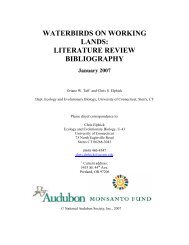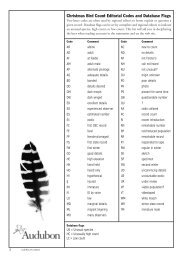audubon strategic plan 2012-2015
AUDUBON STRATEGIC PLAN 2012-2015 - National Audubon Society
AUDUBON STRATEGIC PLAN 2012-2015 - National Audubon Society
- No tags were found...
Create successful ePaper yourself
Turn your PDF publications into a flip-book with our unique Google optimized e-Paper software.
miSSi SSippifly waythe chapternetworkLouisiana ChapterSanctuariesIn Louisiana, the Orleans AudubonSociety and Baton RougeAudubon Society maintain anetwork of coastal sanctuariesthat provide critical habitat forhundreds of bird species, includingmany of the MississippiFlyway priority birds. The coastalforest habitats that theseChapters actively conserveencompass migratory stopoverhabitat for countless warblers,vireos, grosbeaks, flycatchers,hummingbirds, tanagers,and other species that travelacross the Gulf of Mexico twiceeach year. The beach, marsh,and riverine forest habitatsalso preserved in this Chaptersanctuary network are hometo many other species, fromthe Clapper Rail (below) to theProthonotary Warbler.Saving i mportant Bird a reaSMississippi River Deltaafter the bp oil spill thrust the fragile ecosystem of the Mississippi River Delta intopublic view, Audubon brought all its resources to bear to help rescue the birds victimized bythe disaster and to support recovery efforts. More than 35,000 people contacted us to volunteer,and we put 2,500 to work helping oil-soaked pelicans and other birds and wildlife.In the spill’s aftermath, Audubon’s policy team and grassroots activists were instrumentalin gaining national support for ongoing recovery work in the delta. This led to the introductionof federal legislation that, if passed, will direct billions of dollars to restoration.In fact, Audubon had been leading the fight to protect and restore the delta for manyyears before the spill, through an array of innovative efforts, both science-based and legislative.The goal is to restore this vital and unique ecosystem and reestablish the natural,life-giving cycles of the Mississippi River, from its headwaters to the Gulf of Mexico.Audubon’s oldest and largest preserve, Louisiana’s Paul J. Rainey Wildlife Sanctuary,has been conserved since 1924. Audubon staff made the sanctuary into the centerpiece of aunique and powerful conservation alliance with neighboring landowners. The alliance sup-ports more than 170,000 contiguous acres of coastal wetlands and is pioneering new restorationstrategies, including development of a new type of dredge to rebuild damaged wetlands.The effort expanded with a pace-setting gift from the Walton Family Foundation, whichallowed Audubon to bring its unique capacities to bear on the entire coast in partnershipwith the Environmental Defense Fund and the National Wildlife Federation. Now, from themouth of the river to the halls of Congress, Audubon and its partners are forging and implementinga new vision for the nation’s relationship with the Mississippi River and its delta.theory of Victory: Audubon will advance groundbreaking science, engage more supporters,and pass key state and federal legislation to change Mississippi River management to restorethe delta and coast for people and birds, and improve the health of the Gulf of Mexico.the Bottom Line: Conservation impact on 3.5 million U.S. acres; improved outcomesfor 11 priority bird species.the centernetworkAudubon Centerat RiverlandsAudubon partnered with theU.S. Army Corps of Engineersto open a conservation andeducation center near St.Louis, Missouri, at the heart ofthe flyway and the confluenceof the Missouri and MississippiRivers. The AudubonCenter at Riverlands is locatedwithin the Great Rivers ConfluenceImportant Bird Areabut is also near a diverseurban center. In addition toproviding essential habitat toresident and migratory birds,it offers unique opportunitiesfor local residents to connectwith nature. The Center issurrounded by 3,700 acresof prairie marsh and forest,which form an importantwetlands complex for migrating,nesting, and winteringwaterbirds. Center staffers arealso working toward bettermanagement of 100,000 acresof nearby public lands, andwill be engaging birders in acitizen science effort to understandhow birds are usingthose habitats and how theyrespond to positive habitatmanagement changes.46 Audubon StrA tegic PlA nAudubon StrA tegic PlA n 47


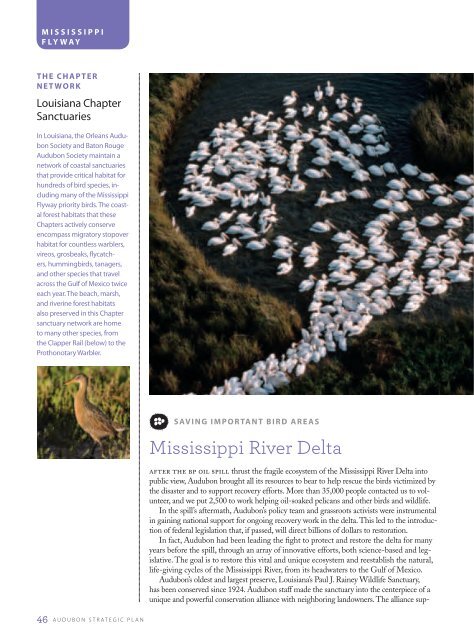



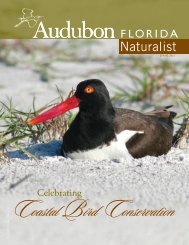
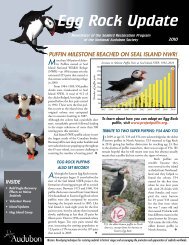
![Full report [PDF] - the Boreal Songbird Initiative](https://img.yumpu.com/52893853/1/190x259/full-report-pdf-the-boreal-songbird-initiative.jpg?quality=85)
